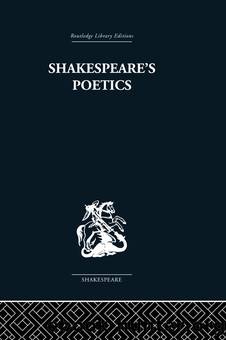Shakespeare's Poetics by Fraser Russell A

Author:Fraser, Russell A. [Russell A Fraser]
Language: eng
Format: epub
ISBN: 9781136561399
Publisher: Taylor & Francis (CAM)
The state itself is gored. (5.3.320) The masters who have its leading, turn it to a shambles. But the masters also are turned or bemonstered:
You men, you beasts.
(Romeo and Juliet, 1.1.90)
Edmund, the chief among them, is toad-spotted (5.3.138): it is the venom of the toad Edgar glances at in him.2 Unaccommodated man, divested of nurture, is kin to the animal; at last he is an animal himself. (2.4.269f.) Kent, reduced, is a fellow to the monkey. (2.4.7-9) Gloucester, reduced, goes down to the bear pit. (3.7.54) Edgar, in the character of a madman, is hog, fox, wolf, dog, and lion (3.4.95-97), all of them fit terms for the old stock, the thing itself.
Shakespeare is not singular in spying out in man the capacity of all ill, which stripes may move but not kindness. The Seven Deadly Sins, whose sum is man in what Hobbes called the condition of mere nature, find their appropriate and conventional emblem in the brutish creatures to whom Poor Tom compares himself.3 The monstrous caricatures of human beings, animal-like, vegetable-like, nightmarish in what they are and what they do, in the pseudo-Rabelaisian Songes drolatiques, hint broadly, I suppose, at the fund of strange and bizarre possibilities in man. The image in medieval art of an ape or monkey in chains betokens the state of man before the New Revelation. In the art of the Renaissance, the same image depicts the quelling of manâs latent bestiality. The ape, who resembles man without the stiffening and distinguishing mark of reason, is taken as the symbol of everything sub-human in man. That is his use in Renaissance sculpture, to dramatize the debased condition of the soul enslaved by matter.1
Cousin to the ape is the wild man or woodwose, a semihuman creature of great antiquity, pre-Christian in his origins, who is believed to inhabit the forests. When Edward Hall chronicles the coronation of Anne Boleyn, he remarks particularly âa foyst or wafter full of ordnanceââ a barge on the Thames,
in which was a great dragon continually moving and casting wild fire, and round about the foyst stood terrible monsters and wild men, casting fire and making hideous noise.2
Download
This site does not store any files on its server. We only index and link to content provided by other sites. Please contact the content providers to delete copyright contents if any and email us, we'll remove relevant links or contents immediately.
The Power of Myth by Joseph Campbell & Bill Moyers(1014)
Half Moon Bay by Jonathan Kellerman & Jesse Kellerman(954)
Inseparable by Emma Donoghue(937)
A Social History of the Media by Peter Burke & Peter Burke(936)
The Nets of Modernism: Henry James, Virginia Woolf, James Joyce, and Sigmund Freud by Maud Ellmann(836)
The Spike by Mark Humphries;(766)
The Complete Correspondence 1928-1940 by Theodor W. Adorno & Walter Benjamin(749)
A Theory of Narrative Drawing by Simon Grennan(742)
Culture by Terry Eagleton(724)
Ideology by Eagleton Terry;(696)
Bodies from the Library 3 by Tony Medawar(683)
World Philology by(678)
Farnsworth's Classical English Rhetoric by Ward Farnsworth(674)
Game of Thrones and Philosophy by William Irwin(671)
High Albania by M. Edith Durham(659)
Adam Smith by Jonathan Conlin(648)
A Reader’s Companion to J. D. Salinger’s The Catcher in the Rye by Peter Beidler(647)
Comic Genius: Portraits of Funny People by(616)
Monkey King by Wu Cheng'en(611)
